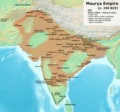File:Maurya Empire, c.250 BCE.png
外观

本预览的尺寸:642 × 600像素。 其他分辨率:257 × 240像素 | 514 × 480像素 | 822 × 768像素 | 1,200 × 1,121像素。
原始文件 (1,200 × 1,121像素,文件大小:2.3 MB,MIME类型:image/png)
文件历史
点击某个日期/时间查看对应时刻的文件。
| 日期/时间 | 缩略图 | 大小 | 用户 | 备注 | |
|---|---|---|---|---|---|
| 当前 | 2024年1月29日 (一) 02:15 |  | 1,200 × 1,121(2.3 MB) | Avantiputra7 | as per discussions added labelling of provinces |
| 2023年11月22日 (三) 06:40 |  | 1,200 × 1,121(2.06 MB) | Avantiputra7 | Reverted to version as of 05:59, 22 November 2023 (UTC) no justification for changing to less legible version of exactly the same map | |
| 2023年11月22日 (三) 06:14 |  | 1,500 × 1,309(2.93 MB) | Indo12122 | Reverted to version as of 05:34, 22 November 2023 (UTC) Stop hijacking. | |
| 2023年11月22日 (三) 05:59 |  | 1,200 × 1,121(2.06 MB) | Avantiputra7 | Reverted to version as of 05:06, 22 November 2023 (UTC) | |
| 2023年11月22日 (三) 05:34 |  | 1,500 × 1,309(2.93 MB) | Indo12122 | Reverted to version as of 19:00, 21 November 2023 (UTC) | |
| 2023年11月22日 (三) 05:06 |  | 1,200 × 1,121(2.06 MB) | Avantiputra7 | Reverted to version as of 18:13, 21 November 2023 (UTC) rv vandalism | |
| 2023年11月21日 (二) 19:00 |  | 1,500 × 1,309(2.93 MB) | Indo12122 | Reverted to version as of 17:53, 21 November 2023 (UTC) Adding Gedrosia .Ray, Himanshu Prabha (2003). The Archaeology of Seafaring in Ancient South Asia. Cambridge University Press. ISBN 978-0-521-01109-9. In spite of the vagueness of the historical texts, the consensus among scholars is that the treaty concluded between Candragupta Maurya and Seleucus acknowledged Indian control of territories to the west of the Indus. These included Gedrosia, Paropamisadae (the region of Kabul and Begram) a... | |
| 2023年11月21日 (二) 18:13 |  | 1,200 × 1,121(2.06 MB) | Avantiputra7 | Reverted to version as of 17:07, 21 November 2023 (UTC) no justification for changing to less legible version of exactly the same map | |
| 2023年11月21日 (二) 17:53 |  | 1,500 × 1,309(2.93 MB) | Indo12122 | Reverted to version as of 16:58, 21 November 2023 (UTC) | |
| 2023年11月21日 (二) 17:07 |  | 1,200 × 1,121(2.06 MB) | Avantiputra7 | Reverted to version as of 16:36, 21 November 2023 (UTC) |
文件用途
以下页面使用本文件:
全域文件用途
以下其他wiki使用此文件:
- bh.wikipedia.org上的用途
- en.wikipedia.org上的用途
- en.wiktionary.org上的用途
- hy.wikipedia.org上的用途
- ko.wikipedia.org上的用途
- si.wikipedia.org上的用途
- sv.wikipedia.org上的用途
- ta.wikipedia.org上的用途

